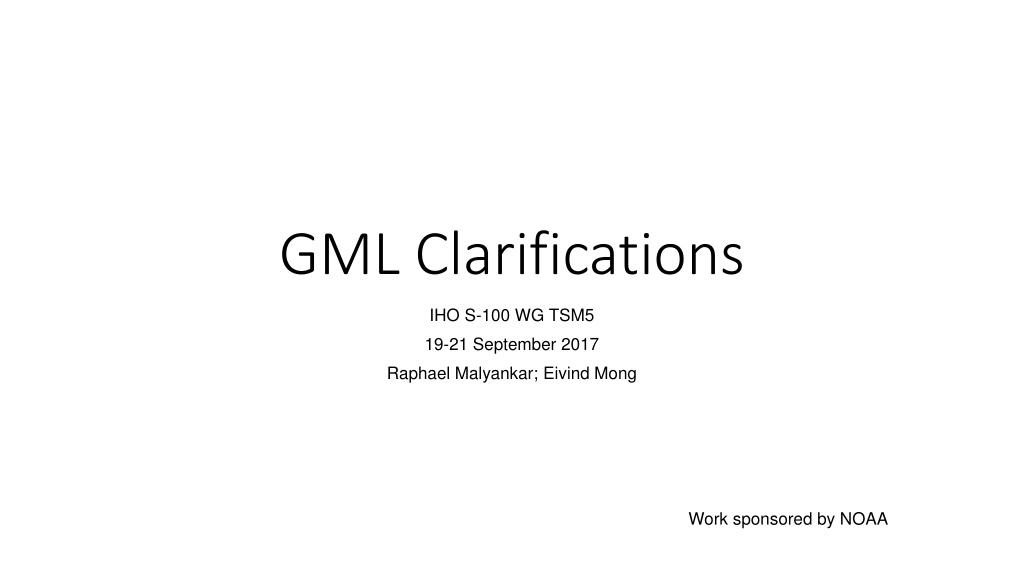
GML Clarifications and Modifications Overview
Explore the proposed modifications to GML, including enhancements to splines, miscellaneous clarifications, and the incorporation of rules and conventions for vector data products. Learn about the implications and conventions described in Part 10b of the presentation.
Download Presentation

Please find below an Image/Link to download the presentation.
The content on the website is provided AS IS for your information and personal use only. It may not be sold, licensed, or shared on other websites without obtaining consent from the author. If you encounter any issues during the download, it is possible that the publisher has removed the file from their server.
You are allowed to download the files provided on this website for personal or commercial use, subject to the condition that they are used lawfully. All files are the property of their respective owners.
The content on the website is provided AS IS for your information and personal use only. It may not be sold, licensed, or shared on other websites without obtaining consent from the author.
E N D
Presentation Transcript
GML Clarifications IHO S-100 WG TSM5 19-21 September 2017 Raphael Malyankar; Eivind Mong Work sponsored by NOAA
Overview of proposal/presentation The proposal for Part 10b contains: Modifications arising from splines (1 slide) Miscellaneous clarifications and a correction (1 slide) Conventions for GML datasets (the rest of this presentation) 2
Modifications arising from splines 10b-8.5.2: Additional interpolation types corresponding to the splines proposal. Polynomial interpolation: interpolation type polynomialSpline Bezier interpolation: bezierSpline B-spline interpolation: bSpline Blended parabolic curve fitting: blendedParabolic For details, see the redline markup of Part 10b and Part 7. The pending new draft of ISO 19107 clarifies that interpolation types can be extended. 10b-8.7: Splines added to level 2 in declaration of GML profile levels 3
Miscellaneous clarifications 10b-9.5.2: Correct tag in the example on page 14 Part 10b 10b-9.6.1 and 10b-9.6.2: Add tables providing details of Dataset Identification and Dataset Structure elements. These were defined when the GML profile was originally introduced as header elements corresponding to similar elements in the ISO 8211 encoding. 4
Incorporation of GML rules and implications The proposed additions explicitly state conventions that will apply to all product specifications that use GML for vector data products. The GML specification includes more rules than pure XML structure and syntax, for example: Feature class names in UML model -> tags Attributes -> contained elements (not XML attributes) Each data product defines its own GML application schema (XSD) that defines structure, syntax and (some) constraints but applications can process feature data without reference to the GML application schemas. There are existing off-the-shelf applications that can do this e.g., QGIS. An example is shown on the next slide. Structure in XML file Structure in prod. spec. application schema (UML) 5
Screen capture of sample S-122 GML data (displayed in off-the-shelf app) 6
Conventions and implications described in Part 10b Explicit statement that the GML specification rules continue to apply. The reason: A profile of GML is supposed to be a subset of GML. XML tags camel case codes. Enumerations or codelists use code, label, or alias from feature catalogue as values. Can* add a field to dataset structure information to specify which. Spatial object tags are S100:Point from the GML profile. Spatial objects are geometry that is not encoded inside a feature, but separately. Associations use xlink:href and at least one of role or arcrole XML attributes Feature class names in UML model -> tags Attributes -> contained elements (not XML attributes) Reserved tags: member , imember , geometry , location *new extension not in posted proposal/redline add? 7
Guidance for application developers in Part 10b This guidance is a consequence of XML and GML: Each dataset has a single root element ( ROOTELEMENT ). GML datasets are XML documents and this is an XML requirement. The tags member and imember are reserved for use as wrapper tags for feature and information types. Use of these wrapper tags is optional in S-100 GML application schemas. Given the path /ROOTELEMENT/member/X1/X2 then X1 is a feature and X2 is an attribute or association role. Similarly given /ROOTELEMENT/imember/X1/X2 X1 is an information type and X2 one of its attributes or associations. If X2 has XML attributes xlink:href and xlink:role and/or xlink:arcrole it is an association role. If X2 has element content it is a complex or spatial attribute. A spatial attribute or object will have one of the allowed spatial properties as its content. (Point, etc.) If X2 is empty and nilled, or has text or numeric content, it is a simple attribute. Applications must allow for the presence or absence of namespaces, e.g. X1 might be of the form S122:FeatureA, etc. Namespaces in XML precede a ':' so it is possible for applications to distinguish the namespace part of the tag from the local name part. 8
